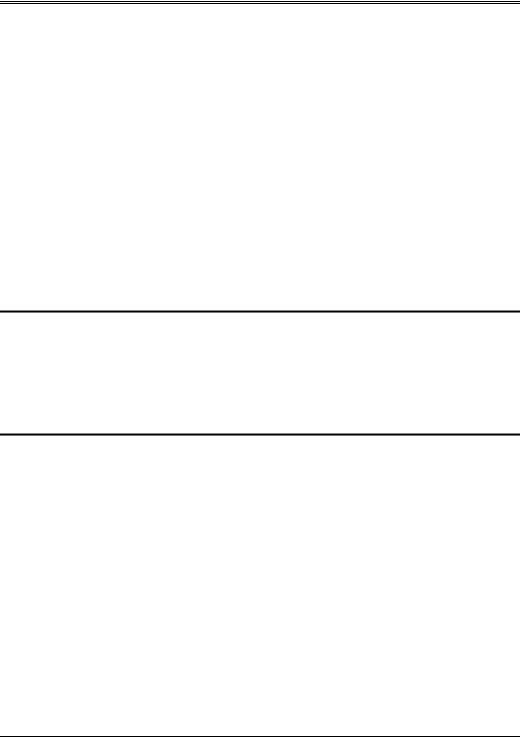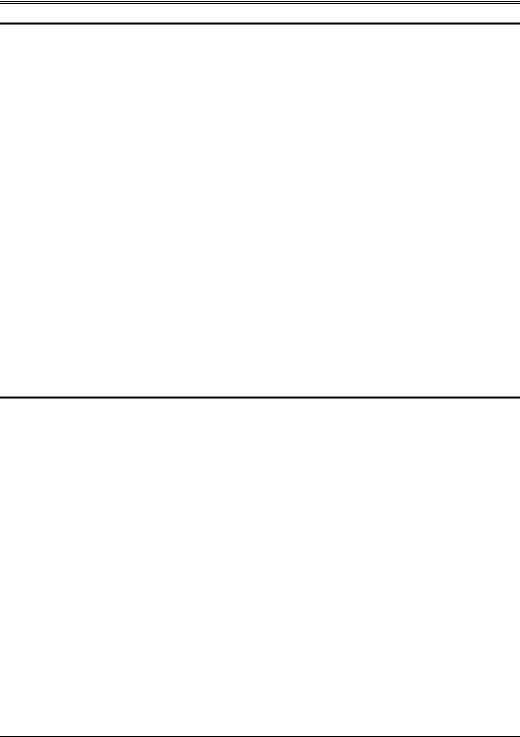
- •About This Book
- •Chapter 1: EISA Overview
- •Introduction
- •Compatibility With ISA
- •Memory Capacity
- •Synchronous Data Transfer Protocol
- •Enhanced DMA Functions
- •Bus Master Capabilities
- •Data Bus Steering
- •Bus Arbitration
- •Edge and Level-Sensitive Interrupt Requests
- •Automatic System Configuration
- •EISA Feature/Benefit Summary
- •Chapter 2: EISA Bus Structure Overview
- •Chapter 3: EISA Bus Arbitration
- •EISA Bus Arbitration Scheme
- •Preemption
- •Example Arbitration Between Two Bus Masters
- •Memory Refresh
- •Chapter 4: Interrupt Handling
- •ISA Interrupt Handling Review
- •ISA Interrupt Handling Shortcomings
- •Phantom Interrupts
- •Limited Number of IRQ Lines
- •EISA Interrupt Handling
- •Shareable IRQ Lines
- •Phantom Interrupt Elimination
- •Chapter 5: Detailed Description of EISA Bus
- •Introduction
- •Address Bus Extension
- •Data Bus Extension
- •Bus Arbitration Signal Group
- •Burst Handshake Signal Group
- •Bus Cycle Definition Signal Group
- •Bus Cycle Timing Signal Group
- •Lock Signal
- •Slave Size Signal Group
- •AEN Signal
- •EISA Connector Pinouts
- •Chapter 6: ISA Bus Cycles
- •Introduction
- •8-bit ISA Slave Device
- •16-bit ISA Slave Device
- •Transfers With 8-bit Devices
- •Transfers With 16-bit Devices
- •Standard 16-bit Memory ISA bus Cycle
- •Standard 16-bit I/O ISA bus Cycle
- •ISA DMA Bus Cycles
- •ISA DMA Introduction
- •8237 DMAC Bus Cycle
- •Chapter 7: EISA CPU and Bus Master Bus Cycles
- •Intro to EISA CPU and Bus Master Bus Cycles
- •Standard EISA Bus Cycle
- •General
- •Analysis of EISA Standard Bus Cycle
- •Performance Using EISA Standard Bus Cycle
- •Compressed Bus Cycle
- •General
- •Performance Using Compressed Bus Cycle
- •General
- •Analysis of EISA Burst Transfer
- •Performance Using Burst Transfers
- •DRAM Memory Burst Transfers
- •Downshift Burst Bus Master
- •Chapter 8: EISA DMA
- •DMA Bus Cycle Types
- •Introduction
- •Compatible DMA Bus Cycle
- •Description
- •Performance and Compatibility
- •Type A DMA Bus Cycle
- •Description
- •Performance and Compatibility
- •Type B DMA Bus Cycle
- •Description
- •Performance and Compatibility
- •Type C DMA Bus Cycle
- •Description
- •Performance and Compatibility
- •EISA DMA Transfer Rate Summary
- •Other DMA Enhancements
- •Addressing Capability
- •Preemption
- •Buffer Chaining
- •Ring Buffers
- •Transfer Size
- •Chapter 9: EISA System Configuration
- •ISA I/O Address Space Problem
- •EISA Slot-Specific I/O Address Space
- •EISA Product Identifier
- •EISA Configuration Registers
- •EISA Configuration Process
- •General
- •Configuration File Naming
- •Configuration Procedure
- •Configuration File Macro Language
- •Example Configuration File
- •Example File Explanation
- •Chapter 10: EISA System Buses
- •Introduction
- •Host Bus
- •EISA/ISA Bus
- •Chapter 11: Bridge, Translator, Pathfinder, Toolbox
- •Bus Cycle Initiation
- •Bridge
- •Translator
- •Address Translation
- •Command Line Translation
- •Pathfinder
- •Toolbox
- •Chapter 12: Intel 82350DT EISA Chipset
- •Introduction
- •EISA Bus Controller (EBC) and EISA Bus Buffers (EBBs)
- •General
- •CPU Selection
- •Data Buffer Control and EISA Bus Buffer (EBB)
- •General
- •Transfer Between 32-bit EISA Bus Master and 8-bit ISA Slave
- •Transfer Between 16-bit EISA Bus Master and 8-bit ISA Slave
- •Transfer Between 16-bit ISA Bus Master and 8-bit ISA Slave
- •Transfer Between 16-bit ISA Bus Master and 16-bit ISA Slave
- •Transfer Between 32-bit Host CPU and 32-bit Host Slave
- •Transfer Between 32-bit Host CPU and 8-bit ISA Slave
- •Transfer Between 32-bit Host CPU and 16-bit ISA Slave
- •Transfer Between 32-bit Host CPU and 16-bit EISA Slave
- •Transfer Between 32-bit Host CPU and 32-bit EISA Slave
- •Address Buffer Control and EBB
- •Host CPU Bus Master
- •EISA Bus Master
- •ISA Bus Master
- •Refresh Bus Master
- •DMA Bus Master
- •Host Bus Interface Unit
- •ISA Bus Interface Unit
- •EISA Bus Interface Unit
- •Cache Support
- •Slot-Specific I/O Support
- •Clock Generator Unit
- •I/O Recovery
- •Testing
- •ISP interface unit
- •82357 Integrated System Peripheral (ISP)
- •Introduction
- •NMI Logic
- •Interrupt Controllers
- •DMA Controllers
- •System Timers
- •Central Arbitration Control
- •Refresh Logic
- •Miscellaneous Interface Signals
- •Glossary
- •Index

Chapter 5: Detailed Description of EISA Bus
are designed to recognize that these upper address lines carry inverted address information (0 on a line is a logical 1 and a 1 is a logical 0).
Since the address information on the LA bus shows up sooner than the address on the SA bus (due to address pipelining and the fact that the LA bus bypasses the address latch on the system board), memory cards that use the LA lines can perform an early address decode. This allows the memory card designer to use slightly slow (inexpensive) memory chips and yet achieve higher throughput. In addition, the fact that the LA bus now includes the lower part of the address bus allows memory cards that use SCRAM or Page Mode RAM to determine if the next access will be in the same row of memory (because the row portion of the DRAM address is carried over the lower portion of the address bus).
The EISA specification also adds the four byte enable signal lines, BE#[3:0], allowing 32-bit bus masters to generate addresses in doubleword address format (A[31:2] plus the BE lines) and 32-bit slaves to see the address in 32-bit doubleword format.
Data Bus Extension
The EISA specification extends the width of the data bus by adding two additional data paths consisting of SD[23:16] and D[31:24]. Using these data paths plus the two ISA data paths allows 32-bit bus masters to transfer four bytes (a doubleword) during a single transfer when communicating with 32-bit slaves.
Bus Arbitration Signal Group
Under EISA, two signals have been added to allow implementation of bus master cards. They are described in table 5-1.
45

EISA System Architecture
Table 5-1. EISA Bus Master Handshake Lines
|
Signal Name |
|
|
Full Name |
|
|
Description |
|
|
|
|
|
|
|
|
|
|
|
MREQx# |
|
|
Master Request for slot x |
|
|
When a bus master in a slot requires |
|
|
|
|
|
|
|
|
the use of the bus to perform a trans- |
|
|
|
|
|
|
|
|
fer, it asserts its slot-specific MREQx# |
|
|
|
|
|
|
|
|
signal line. This signal is applied to the |
|
|
|
|
|
|
|
|
CAC on the system board, which then |
|
|
|
|
|
|
|
|
arbitrates its priority against other |
|
|
|
|
|
|
|
|
pending bus requests. |
|
|
|
|
|
|
|
|
|
|
|
MAKx# |
|
|
Master Acknowledge for |
|
|
When the CAC is ready to grant the |
|
|
|
|
|
slot x |
|
|
bus to a requesting bus master |
|
|
|
|
|
|
|
|
(MREQx# is asserted), the CAC asserts |
|
|
|
|
|
|
|
|
the bus master's MAKx# slot-specific |
|
|
|
|
|
|
|
|
signal line to inform the bus master |
|
|
|
|
|
|
|
|
that it has been granted the bus. |
|
Figure 5-3 illustrates the relationship of the master request and acknowledge lines to the CAC. The subject of bus arbitration is covered in detailed the chapter entitled “EISA Bus Arbitration.”
46

Chapter 5: Detailed Description of EISA Bus
Figure 5-3. The Bus Master Handshake Lines
47

EISA System Architecture
Burst Handshake Signal Group
The EISA specification adds two signal lines to support initiation of burst mode (Type C) bus cycles. They are described in table 5-2.
|
|
|
|
|
Table 5-2. The Burst Handshake Lines |
|
||
|
Signal |
|
|
|
|
|
|
|
|
Name |
|
|
Full Name |
|
|
Description |
|
|
|
|
|
|
|
|
|
|
|
SLBURST# |
|
|
Slave Burst |
|
|
When addressed, a slave asserts SLBURST# to indi- |
|
|
|
|
|
|
|
|
cate that it supports burst cycles. If the slave supports |
|
|
|
|
|
|
|
|
burst cycles, it asserts this signal regardless of the |
|
|
|
|
|
|
|
|
state of the MSBURST# signal line. |
|
|
|
|
|
|
|
|
|
|
|
MSBURST# |
|
|
Master Burst |
|
|
During a bus cycle, the current bus master asserts |
|
|
|
|
|
|
|
|
this line as a response to the assertion of SLBURST#. |
|
|
|
|
|
|
|
|
This informs the addressed slave that the bus master |
|
|
|
|
|
|
|
|
supports burst cycles. |
|
|
|
|
|
|
|
|
|
|
The subject of burst mode (Type C”) bus cycles is covered in detail in the chapter entitled “EISA CPU and Bus Master Bus Cycles.”
Bus Cycle Definition Signal Group
The EISA specification defines a new set of bus cycle definition signal lines. The current EISA bus master uses them to inform the currently addressed slave of the type of bus cycle in progress. Table 5-3 defines the new signals.
Table 5-3. EISA Bus Cycle Definition Lines
|
Signal Name |
|
|
Full Name |
|
|
Description |
|
|
|
|
|
|
|
|
|
|
|
M/IO# |
|
|
Memory or I/O |
|
|
During a bus cycle, M/IO# is set high if a memory |
|
|
|
|
|
|
|
|
address is on the address bus. It is set low if it's an |
|
|
|
|
|
|
|
|
I/O address. |
|
|
|
|
|
|
|
|
|
|
|
W/R# |
|
|
Write or Read |
|
|
During a bus cycle, W/R# is set high if a write bus |
|
|
|
|
|
|
|
|
cycle is in progress and low if a read bus cycle is |
|
|
|
|
|
|
|
|
in progress. |
|
48
